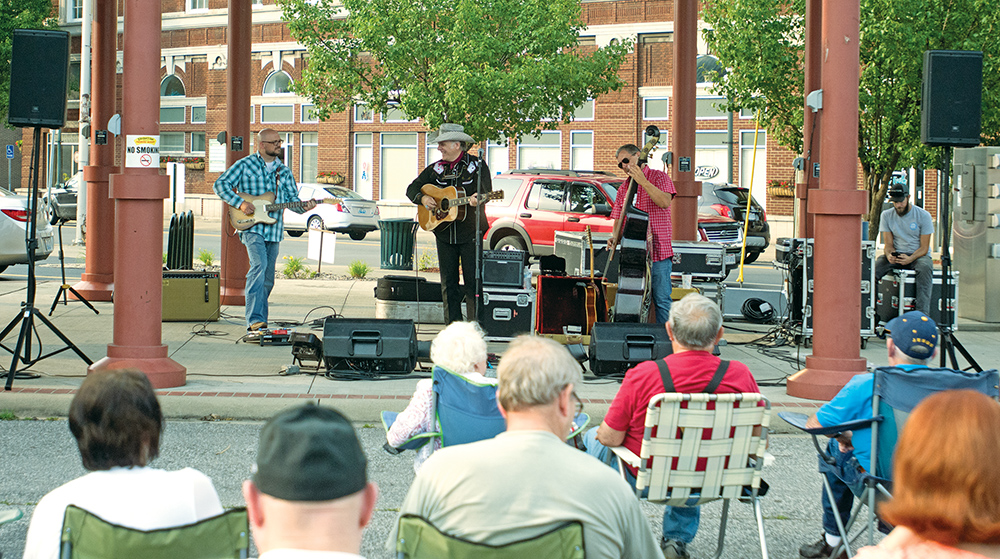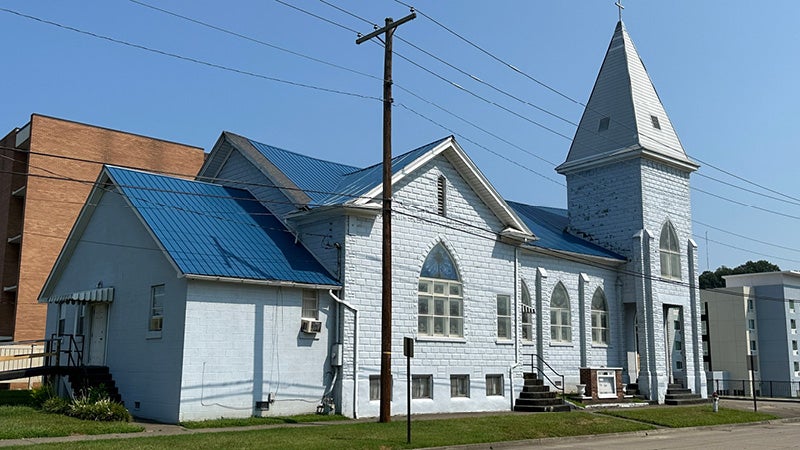The heart of the community
Published 12:00 am Saturday, October 1, 2022

- Broadcasters Mike Todd and Hal Murphy, seen in the 1960s, were partners on WIRO on the morning and evening drive programs on WIRO. Todd, whose last name was Tussey, chose an on air moniker for his radio work. (Submitted photo)
WIRO served Ironton, Tri-State on radio for decades
EDITOR”S NOTE – This is the first in a four-part series, which will run each Saturday through October.
By Gordon Hall
I grew up watching the pulsing red light blinking through the sycamore branches from our front porch on Seventh Street. The red light crowned the top of the tower perched on the plaza above the little radio station on the hill.
And I listened to the voices and the music broadcast from that 205-foot tower: Mac McElroy and Joe Bowman, Noah Don Adams and Mike Todd, Hal Murphy and Ronnie Bell, “Johnny Dollar” and the “Flying Dutchman.”
In time, I would play the hits there and gaze out the control room’s picture window overlooking our hometown toward those razorback Kentucky hills just across the Beautiful Ohio. For so many of us radio boys, it was our place of beginnings — WIRO AM, 1230 KHz, “1-2-3-GO Radio.” Ironton, Ohio.
Here’s our story:
The Founders
WIRO Radio signed on the air in the fall of 1951 at 250 watts of power. Low power, hometown radio stations were called “teapots.” Glacus G. Merrill served as president of the Iron City Broadcasting Company, and Robert Edge was the station’s general manager. Within a year, however, a new group of owners acquired the station license and, beginning in June, 1952, WIRO blossomed.
Keeping the Iron City Broadcasting name, the new team included president and chief engineer Clarence Baker, business manager Ted Nelson, sales manager Pat Shannon and general manager Clinton E. McElroy. The Big I quickly became must-listen-radio deeply invested in the life of its community.

Bob Miller, seen in this 1972 photo, got his start on WIRO and was a nationally-known personality, later winning an award as broadcaster of the year for small markets in Huntington and going on to be a programmer for Gene Autry’s show.
The McElroy Years
Donna Secrist was WIRO’s first secretary/receptionist. When the station changed hands, she stayed on. “They got me when they got the station,” she laughs. It worked out pretty well; Donna married Mac McElroy. They had three children.
Under Mac’s inspired guidance, the new WIRO energized its programming and participated in every possible social event in the listening area:
• Broadcasting Johnny McCoy’s Big Band Orchestra live from the Marting Hotel.
• Greeting downtown business leaders for the “Breakfast at Kresge’s” morning broadcast.
• Hosting meet-and-greet remote music shows at the Frisch’s Big Boy drive-ins on State Route 141 and on Second Street.
• Introducing the Sandman Serenade record request program.
• Showcasing Ironton High School sports.
• Airing the Ironton/Lawrence County’s signature event — the Memorial Day Parade.
• Offering soul-stirring church programs each weekend.
• Investing in innovative DJs who went above and beyond by selflessly, altruistically involving themselves with the personal concerns of their listening family: If your dog was lost, call the Big I. If you needed a hot sports score, call Je-2-1922.
“The community was overwhelmingly receptive,” says Mrs. McElroy. And that community, she points out, ran from Ashland to Greenup, South Point to Wheelersburg, and Waterloo to Kitts Hill.
Another major reason the community responded so enthusiastically was the Big I’s emphasis on presenting up-to-the-minute news and weather. Mac McElroy’s driving motive was simple: “If you read it in the paper, it’s history. If you hear it on the radio, it’s news.”
Then there was the juggernaut of exciting hometown sports on the air. Mac called Ironton High School play-by-play with gusto, and Joe Bowman delivered color commentary with style. It was the beginning of a torrid love affair between WIRO and the Ironton Tigers. And it was Mac McElroy, who on a football Friday night, first called the IHS band the “Million Dollar Marching Band.” (Next time you go to Tanks Memorial Stadium, look toward the band shelter; you’ll see a banner there honoring Mac.)
In 1961, nevertheless, with some of the Iron City partners drifting away, the full burden of running the powerhouse radio station fell upon Clarence and Mac. And Mac’s health was wearing him down. They chose to pass on the WIRO torch.
Clinton McElroy Jr.’s abiding memory of that time is “Everybody in town knew my Mom and Dad, and by extension me, Little Mac. Anything that was going on in Ironton was represented on the Big I. It was Ironton’s heart.”
Beginning his own career as a newsman, Clint’s years in Tri-State radio were consistent ratings and award winners. One of the favorite jobs of his 46 years in broadcasting was managing WIRO’s Fox Sports programming for later owner iHeart Radio, keeping up the family tradition.
Today, he’s in business with his three sons who have more than twenty terrific podcast series to their names. He also writes the NYT Best Selling series of graphic novels, “The Adventure Zone.”
Engineering
An AM radio station emits a circular signal pattern from its tower. The WIRO 1230 AM footprint — once its power increased to 1,000 watts — covered all of Lawrence County and also reached deep into Scioto County, as well as three Kentucky and two West Virginia counties.Put another way, WIRO could be clearly heard in a 20-mile radius from New Boston to Chesapeake and from Grayson to Getaway. The Tri-State radio market of Ironton, Ashland, and Huntington at that time boasted some 50,000 potential listeners.
The Auble Years
Kenneth H. Auble of Orville, Ohio loved radio. Radio consumed his thoughts. His life’s goal, according to his wife Rose, was to own a radio station that was the heart of its community.
Scouting for a radio station to purchase, Ken and Rose Auble stopped in Ironton.

Hal Murphy is seen at Blue Ribbon Lanes in Ashland, Kentucky in the early 1960s. Murphy, who did not work in WIRO’s home studio, was known for his remote segments in the station’s drivetime shows. (Submitted photos)
They’d heard good things about WIRO. Rose recalls the station had “an impeccable reputation.” And it was for sale.
Ken promptly made his bid. The acquisition of Ironton’s hometown radio station by Tri Radio Broadcasting, Inc. became official in February 1962.
Before the ink was dry, Ken Auble set about working tirelessly as president, general manager and chief engineer.
“He loved engineering.” says Rose.
But Ken was not only the Big I’s new engineer; he was its engine. According to one of his DJs, “Ken Auble worked 25 hours a day.”
“Ken’s goal was to make the radio station a vital part of the community,” Mrs. Auble remembers.
He had a sound foundation upon which to build. According to Rose, the dynamic impact of WIRO on its listening community grew ever stronger through Ken’s vision and tireless hard work.
Mrs. Auble was the bookkeeper, check-writer and supervisor of her trusted right hand—the secretary/receptionist who also served as the traffic coordinator, program log typist and sometimes mom to the DJs.
Marlene Ferguson held the position for 20 years, beginning as a high school junior in 1952. Audrey Hunter put in more than a decade of loyal service. And there was always a work-study high school student in the office learning the business of business hands on.
Besides talented disc jockeys playing popular music and constantly updating the news and weather, the Big I also broadcast Ironton City Council meetings and local election returns live.
The beloved tradition of airing the Ironton-Lawrence County Memorial Day Parade — still the longest running such parade in the USA—continued with Ken Auble on the mic.
The commitment to broadcast the best in sports leapt to super heights on his watch. While WIRO proudly aired Cincinnati Reds baseball and Ohio State Buckeyes football, among others, local high school sports drew in a multitude of faithful fans.
Ken’s enduring love for the Ironton High School Fighting Tigers, his voice booming with excitement on the radio broadcasts, proved legendary.
But remember, Ken Auble was also the station engineer. In 1964, he flipped the switch, and WIRO’s power increased to 1,000 daytime watts significantly increasing its coverage area; the signal fell back to 250 watts after local sunset. In 1972, Ken’s love of engineering brought another stellar project to Radio Plaza — WITO FM.
The AM’s sister station took its first steps in 1972 and officially joined the family in the summer of 1973. WITO operated its three kilowatts at 107.1 MHz. The format was County & Western. And the new station welcomed Russell High School Red Devil sports into the fold.
Ken Auble wasn’t finished (Ken was never finished.). He engineered the first completely transistorized, solid state transmitter in the Tri-State and, according to a representative of Harris Radio Equipment Company, most likely the first in America. This innovation not only made the AM sound cleaner but also boosted the reach of the 1230 KHz signal. Ken, still working ahead of the rest of the country, also transistorized other key pieces of studio equipment and most of WITO’s transmitter.
In 1985, after more than 20 years of extraordinary success, Ken’s health was forcing him to slow down. He and Rose sold the Big I stations. Regardless, he continued to be the champion of Ironton’s hometown radio station until his death at age 72 on Sept. 16, 1999.
Next week: Ironton’s hometown radio station—we begin sharing deeply felt memories from the DJs, including Noah Adams and Bob Miller.
Written by Gordon Hall. Copyright on work reserved by the author.
Gordon Hall is a former DJ, broadcast journalist and communications instructor. He began his 30-year radio career at WIRO in 1969.





